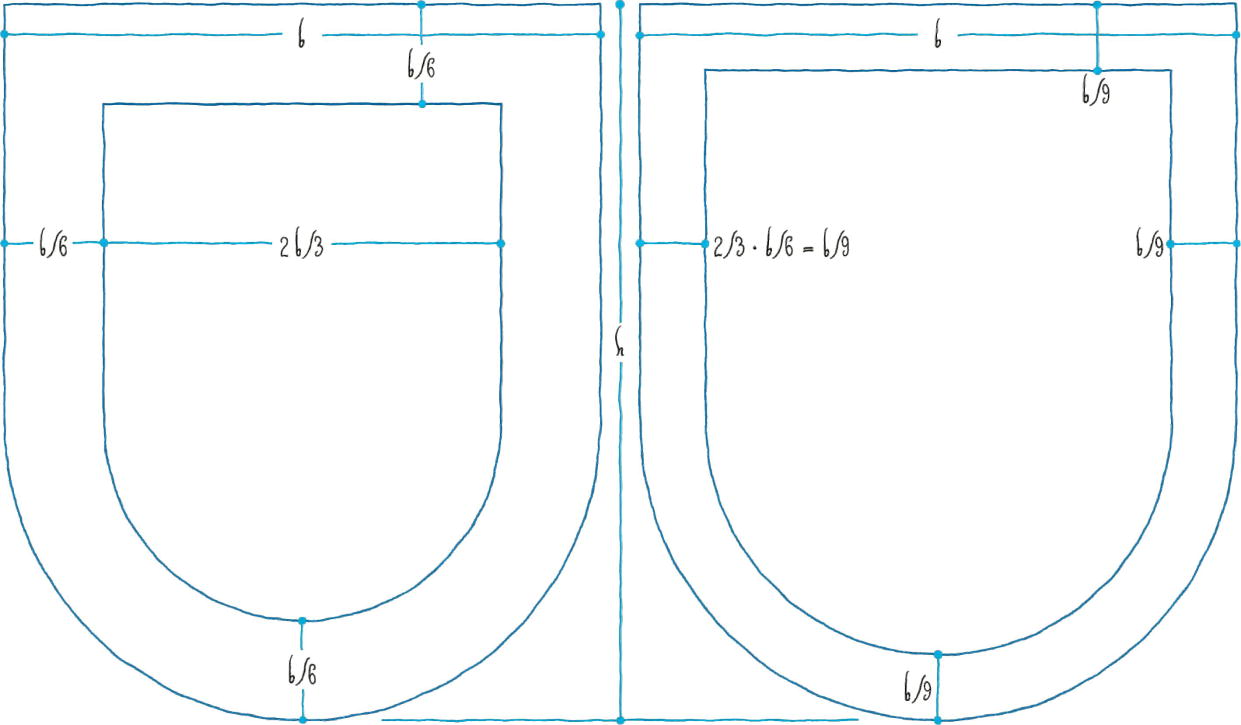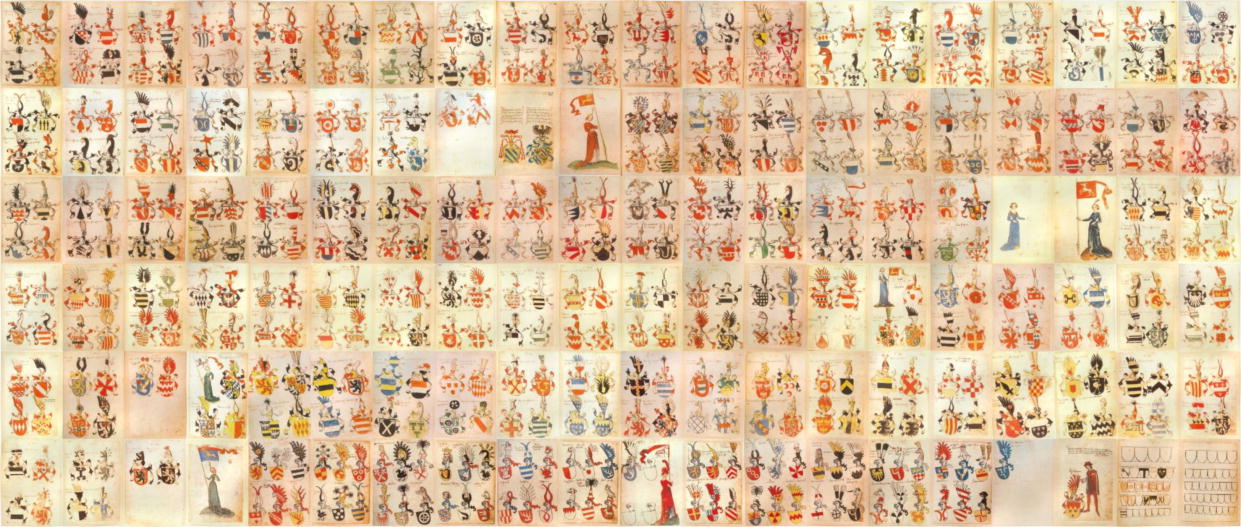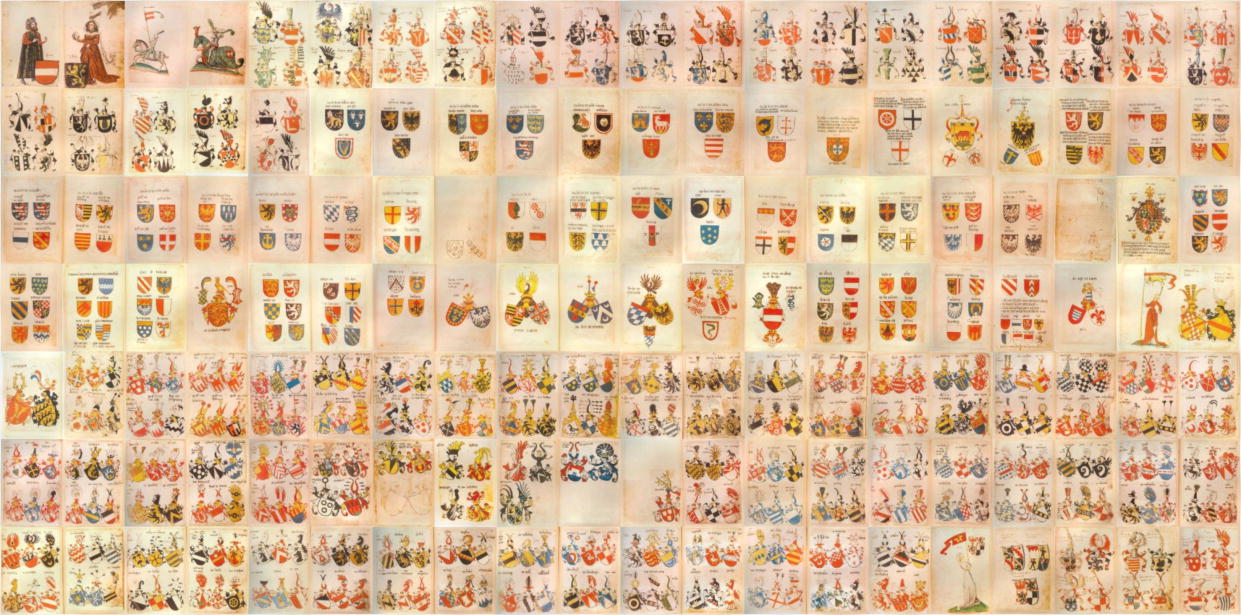
Categories of heraldry
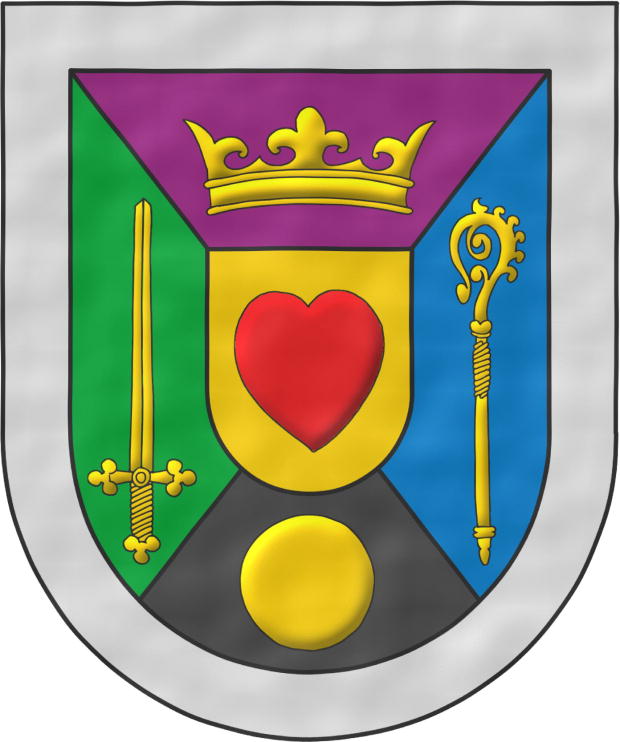
Personal, governance, military, religious, socioeconomic, and, imaginary heraldry.
Quarterly in saltire: 1 Purpure, a crown Or; 2 Vert, a sword point upwards Or; 3 Azure, a crozier Or; 4 Sable, a bezant; an inescutcheon Or charged with a heart Gules; a bordure Argent.
Escudo cuartelado en sotuer: 1o de púrpura, una corona de oro; 2o de sinople, una espada alzada de oro; 3o de azur, un báculo de oro; 4o de sable, un bezante de oro; un escusón de oro cargado de un corazón de gules; una filiera de plata.
Imaginary coat of arms created by me with the following characteristics: its shape is semicircular; its field is enameled with flat tinctures of Purpure, Vert, Azure, Sable, Or, and Argent; all of its figures are illuminated and enameled in Or, except for the heart, which is Gules; and the whole composition has a watercolor finish.
Within the article on my approach to heraldic classification, you can find the symbolism contained within this shield and its category within heraldry.
The original shield design, along with many others, is registered in [Salmerón Cabañas, A.; 2015a; page 30].
All colors and metals
The heraldic colors Gules, Azure, Vert, Sable, and Purpure can be divided into two sets:
- the energetic colors Gules, Azure, and Vert, and
- the neutral colors Sable and Purpure.
Therefore, the Sable-Purpure combination is not the most vibrant.
I use both Sable and Purpure in this design because it incorporates all five colors and both metals, Or and Argent, representing different heraldic disciplines. Note that I have placed Purpure and Sable far apart, precisely due to the initial explanation.
Blazon keywords: Quarterly per saltire, Purpure, Vert, Azure, Sable, Or, Argent, Gules, Crown, Sword, Point upwards, Crozier, Bezant and plate, Inescutcheon and Diminished bordure.
Style keywords: Illuminated, Outlined in sable and Watercolor.
Classification: Created, Imaginary and Coat of arms.
Imaginary bearer: Categories of heraldry.


Categories of heraldry, alternative coat of arms
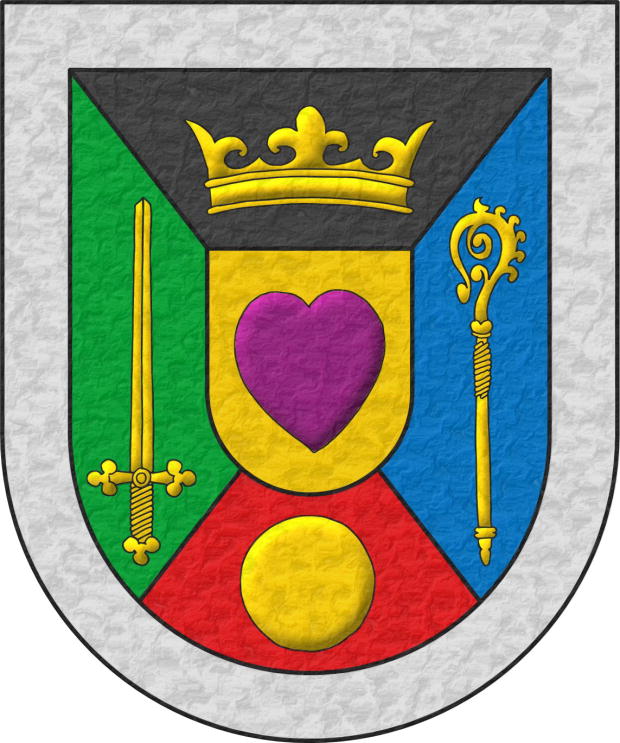
Alternative coat of arms for the heraldry and its categories.
Quarterly in saltire: 1 Purpure, a crown Or; 2 Vert, a sword point upwards Or; 3 Azure, a crozier Or; 4 Sable, a bezant; an inescutcheon Or charged with a heart Gules; a bordure Argent.
Imaginary coat of arms created by me with the following characteristics: its shape is semicircular; its field is enameled with flat tinctures of Purpure, Vert, Azure, Sable, Or, and Argent; all of its figures are illuminated and enameled in Or, except for the heart, which is Gules; and the whole composition has a metallic finish.
These arms are one of the alternatives created during the process of developing a coat of arms for the categories of heraldry.
Blazon keywords: Quarterly per saltire, Purpure, Vert, Azure, Sable, Or, Argent, Gules, Crown, Sword, Point upwards, Crozier, Bezant and plate, Inescutcheon and Diminished bordure.
Style keywords: Illuminated, Outlined in sable and Watercolor.
Classification: Created, Imaginary and Coat of arms.
Imaginary bearer: Categories of heraldry.


Schema of a bordure and a diminished bordure
Proporciones de una bordura y una filiera, una filiera es una bordura con su ancho disminuido en 2/3.
In heraldry, a diminished bordure is a diminished bordure. In the design, it is typically drawn at 2/3 the width of a standard bordure. Since the width of a standard bordure is usually 1/6 of the coat of arms' width, a diminished bordure calculated this way would be 1/9 of the coat of arms' width.
However, diminished bordures can also be found with a width of 1/2 that of a standard bordure, in other words, 1/12 of the coat of arms' width, or 1/3 that of a standard bordure, that is to say, 1/18 of the coat of arms's width.
The so-called bordure of pieces usually has a width of 1/2 that of a standard bordure, which is 1/12 of the coat of arms's width.
Blazon keywords: Without divisions, Bordure and Diminished bordure.
Style keywords: Semi-circular.
Classification: Schema and Coat of arms.
Bearer: Categories of heraldry.


![Ver [Scott-Giles, C. W.; 1965] en referencias bibliográficas. Libro abierto, hojas de plata, filo de oro, guardas de gules, tapas de sable.](../css/Libro.Bibliografia.png)
Scott-Giles, C. W.; 1965
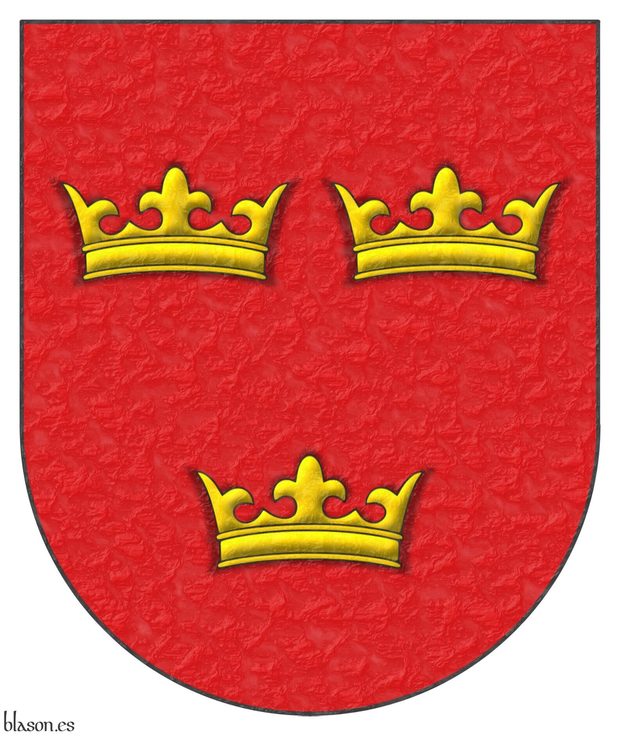
Charles Wilfred Scott-Giles, OBE (Officer of the Most Excellent Order of the British Empire), Fitzalan Pursuivant Extraordinary, «Some Arthurian Coats of Arms», Coat of Arms, COA, An Heraldic Quarterly Magazine, issue 64 of October 1965 (which is the date I use as reference) and issue 65 of January 1966, The Heraldry Society, Baldock, Hertfordshire, October 1965.
The coat of arms illustrating this bibliographic reference is one of the variants described in this article attributed to King Arthur, which in Blason.es is cataloged as Arthur of Britain.
Bibliographical reference of century XX.
Author: Scott-Giles, C. W..
External link:
Internal resources: ScottGilesCW1965.SomeArthurianCoA.docx.


![Ver [Becher, C.; Gamber, O.; 1986] en referencias bibliográficas. Libro abierto, hojas de plata, filo de oro, guardas de gules, tapas de sable.](../css/Libro.Bibliografia.png)
Becher, C.; Gamber, O.; 1986
Charlotte Becher and Ortwin Gamber, «Die Wappenbücher Herzog Albrechts VI. von Österreich: Ingeram-Codex der ehem, Bibliothek Cotta, Volume 1», editado por Böhlau Verlag Wien, 178 pages, ISBN 3-205-05002-9 y 978-32-05050-02-5, Vienna, Cologne, Graz, 1986.
Dedicated exclusively to the study and analysis of the armorial [Ingeram, H.; 1459].
Bibliographical reference of century XX.
Classification: German language, Manuscript, Armorial roll and In color.
Authors: Becher, Charlotte and Gamber, Ortwin.
The following article cites this bibliographic reference:
External link:

![Ver [Ingeram, H.; 1459] en referencias bibliográficas. Libro abierto, hojas de plata, filo de oro, guardas de gules, tapas de sable.](../css/Libro.Bibliografia.png)
Ingeram, H.; 1459
Hans Ingeram, «Ingeram Codex», 142 pages, 1459.
The first owner of this armorial was Archduke Albert VI of Austria. Hans Ingeram included in each page of his book from 1 to 6 coats of arms, he dedicated the initial part to the Habsburg coats of arms, to imaginary coats of arms and to the coats of arms of European kingdoms, generally using 4 coats of arms per page, and dedicated the final 2/3 of its content to depicting 6 coats of arms per page of the lower German nobility, especially nobles belonging to a special type of «associations» whose purpose was the organization of tournaments. A monograph on this armorial can be consulted in [Becher, C.; Gamber, O.; 1986].
Bibliographical reference of century XV.
Classification: Manuscript and Armorial roll.
The author is Ingeram, Hans.
Here are the articles quoting this reference:
External links:


Oschoven of the Rhin
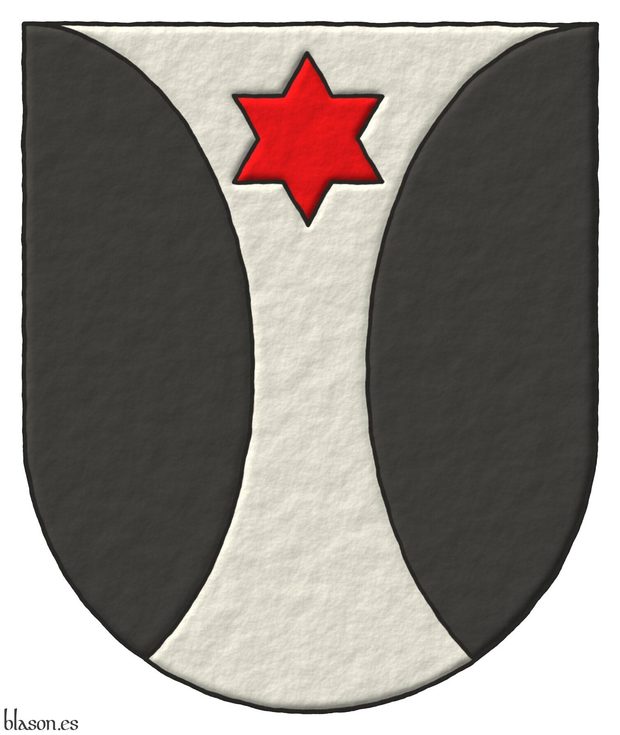
Argent, in chief a mullet of six points Gules, between two flanches Sable
«Oschoven au Rhein» in the book [Menestrier, C. F.; 1659; page 315], it is blazoned «d'argent flanqué arrondi de sable à vne molette de mesme en chef», so the mullet would be Sable, bacause «de mesme» is written, and with a hole in the middle, this hole does not exits in other sources.
In the book [Rietstap, J. B.; 1861], it is blazoned «Argent, flanched in round Sable, Argent charged in chief of a mullet Gules», and in French «d'argent, flanqué en rond de sable, l'argent chargé en chef d'une étoile de gueules».
Blazon keywords: Argent, Sable, Gules, Mullet, Chief, Flanched and Arched.
Style keywords: Semi-circular, Illuminated, Outlined in sable and Freehand.
Classification: Interpreted and Personal.
Bearer: Oschoven of the Rhin.


Haute-Savoie
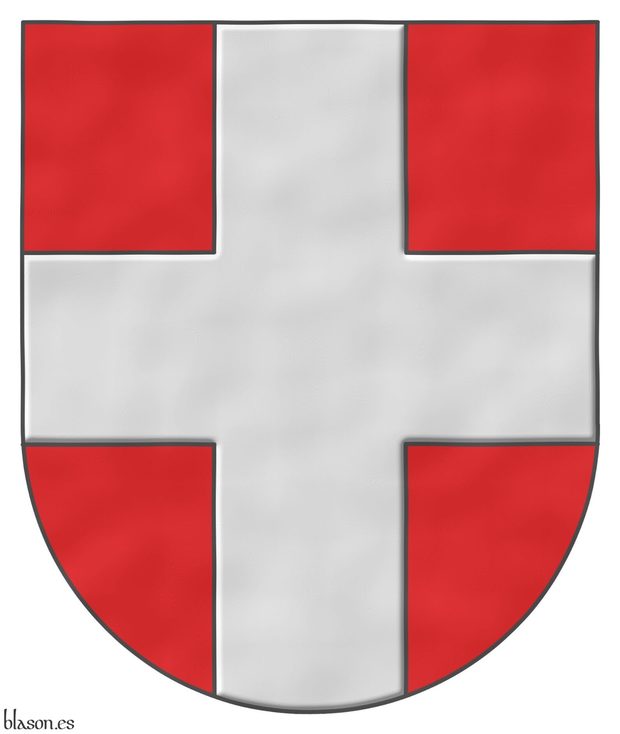
Gules, a cross Argent.
Escudo de gules, una cruz de plata.
Existing coat of arms interpreted by me of the following form: the shape of the shield is semi-circular; the tincture of the field is gules; the tincture of the cross is metal argente; and all the coat of arms has a watercolor finish.
In French its blazon is «de gueules à la croix d'argent».
Blazon keywords: Without divisions, Gules, Argent and Cross.
Style keywords: Semi-circular, Illuminated and Watercolor.
Classification: Interpreted, Civic, Coat of arms and House of Savoy.
Bearer: Saboya, Ducado de.

Sigue por: Scheme with a fess and a cross.
-
Language
-
Categories of heraldry
-
Divisions of the field
- Without divisions
- Party per pale
- Party per fess
- Party per bend sinister
- Tierce
- Tierce sinister
- Tierced per fess
- Tierced per bend
- Tierced pallwise inverted
- Quarterly
- Quarterly per saltire
- Gyronny
- Party per fess, the chief per pale
- Party per pale, the sinister per fess
- Party per fess, the base per pale
- Party per pale, the dexter per fess
- Chapé
- Chaussé
- Party per chevron
- Enté en point
- Flanched
-
Metals
-
Colours
-
Furs
-
Other tinctures
-
Ordinaries and sub-ordinaries
-
Diminutives of the ordinaries
-
Other charges
-
Charges from Nature
Water, Eagle, Bald eagle, Eagle claw, Dorsal fin, Tail fin, Two hands clasped, Lark, Tree, Trunk, Rainbow, Atom, Barbel, Acorn, Bighorn sheep, Arm, Owl, Vulture, Horse, Head, Goat, Camellia, Thistle, Merino ram, Kapok tree, Stag, Doe, Crescent, Increscent, Chrysanthemum, Tail, Tail addorsed, Ermine spot, Hummingbird, Snowflake, Heart, Roe deer, Neck, Roe deers' attires, Raven, Dolphin, Diamond, Tooth, Elephant, Emerald, Starling, Mullet, Mullet of four points, Star of David, Estoile, Male figure, Fleur de lis, Flower, Cornflower, Dogwood flower, Lotus flower, Hop cone, Bluebonnet, Puffin, Ash, Rooster, Claw, Talon, Goose, Heron, Seagull, Pomegranate, Sunflower, Swallow-tail, Falcon, Leaf, Boar, Goldfinch, Laurel, Barn owl, Lion, Lioness, Lion passant, Leopard, Lion rampant guardant, Lynx, Lily, Madonna lily, Flame, Wolf, She-wolf, Parrot, Moon, Hand, Apple, Apple tree, Martlet, Wing, Two wings in vol, Covert, Blackbird, Mount, Trimount, Fly, Wrist, Elm, Olive tree, Orbital, Bear, Palm frond, Palm tree, Dove, Poplar leaf, Jaguar, Paw, Forepaw, Foot (palmiped), Foreleg, Peacock, Chest, Pelican, Pelican in her piety, Dog, Brach hound, Fish, Hoof, Beak, Quill, Cinquefoil, Quetzal, Branch, Sprig, Frog, Shamrock, Caboshed, Oak, Holm oak, Rose, Double rose, Savage, Serpent, Plough of Ursa Major, Sun, Sun in splendour, Ray of the sun, Stem, Badger, Tyger, Linden, Wheat, Wheat spike, Bull, Tulip, Udder, Escallop and Fox.
-
Artificial charges
Halberd, Plough share, Ace of spades, Anchor, Cyclamor, Torch, Bow, Arch, Harp, Non-classic artifact, Winnowing fan, Crozier, Conductor's baton, Pair of scales, Ship, Norman ship, Beret, Grenade, Ecclesiastical cap, Arm vambraced, Chain, Covered cup, Monstrance, Bell, Bell tower, Cannon dismounted, Carbuncle, Castle, Clarion, Nail, Cord, Dagger, Key ward, Turret, With a turret, Armillary sphere, Sword, Sabre, Parchment, Scroll, Arrow, Club, Garb, Sheaf of tobacco, Scythe, Gauntlet, Axe, Buckle, Galician granary, Polish winged hussar, Church, Oil lamp, Spear, Spear's head, Fleam, Letter, Book, Open book, Closed book, Bookmark, Page, Line, Lantern, Key, Four crescents joined millsailwise, Hammer, Menorah, Mortar, Pestle, Number, Knot, Celtic Trinity knot, Water-bouget, Comb, Piano, Millstone, Millrind, Millwheel, Clay pot, Bridge, Cuffed, Hourglass, Chess rooks, Compass rose, Rosette of acanthus leaves, Mullet of six points pierced, Broken, Portcullis, Wheel, Wagon-wheel, Symbol, Sackbut, Drum, Tower, Trident, Trumpet, Double vajra and Anvil.
-
Immaterial charges
Angel, Heart enflamed, Sacred Heart of Jesus, Paschal lamb, Dragon, Wyvern, Phoenix, Garuda, Griffin, Sea-griffin, Winged hand, Our Lady of Mercy, Pegasus, Saint George, Mermaid, Trinity, Triton, Golden fleece, Unicorn and Ouroboros.
-
External elements
-
Heraldic creations
-
References
-
Formats
-
Keywords on this page
Watercolor, Point upwards, Armorial roll, Azure, Bezant and plate, Bibliography, Bordure, Crozier, House of Savoy, Categories of heraldry, Crown, Created, Cross, Quarterly per saltire, Arched, Outlined in sable, In color, Coat of arms, Inescutcheon, Sword, Schema, Mullet, Fess, Diminished bordure, Flanched, Personal, Gules, Illuminated, Imaginary, Interpreted, Chief, German language, Manuscript, Semi-circular, Ordered, Or, Oschoven of the Rhin, Argent, Without divisions, Civic, Purpure, Kingdom of England, Sable, Saboya, Ducado de, Century XV, Century XX, Vert and Freehand.
